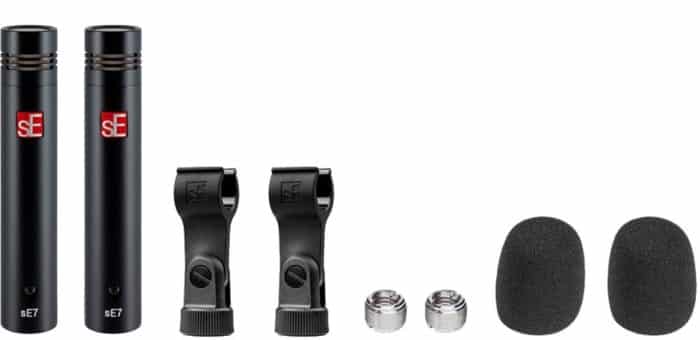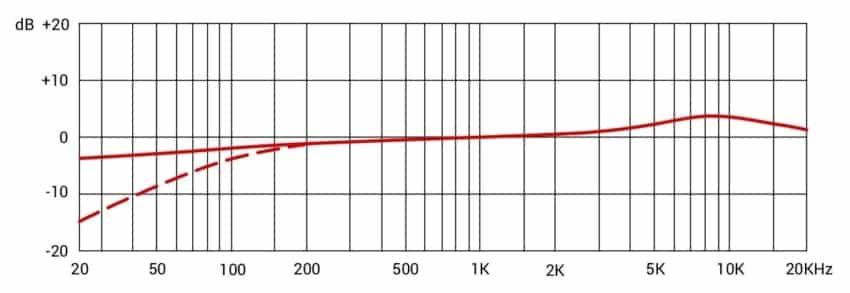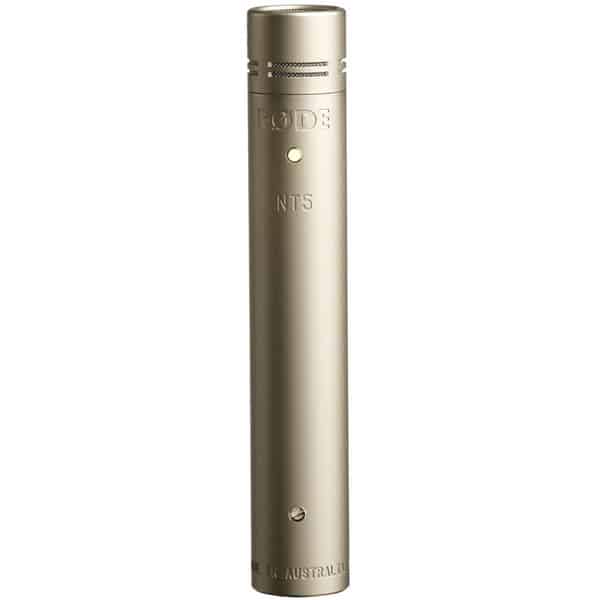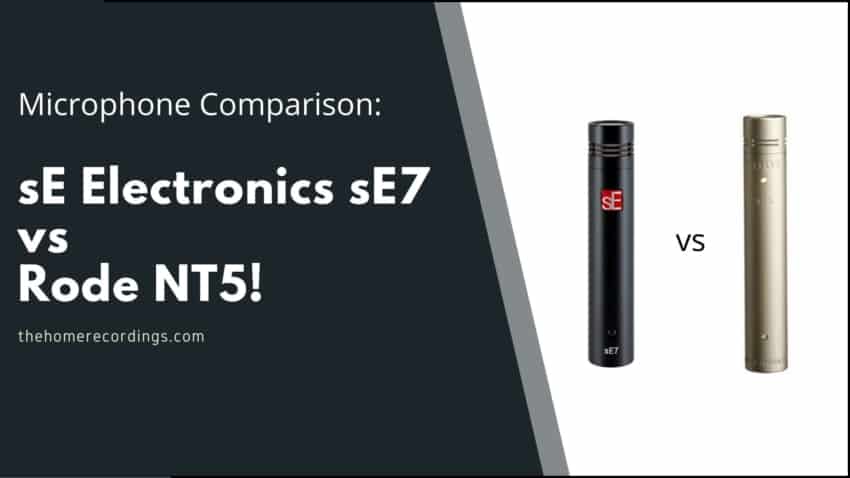Last updated on December 29th, 2023 at 09:55 pm
Anyone who is interested in music production probably already knows about the Rode NT5’s and how these small diaphragm condenser microphones are considered to be one of the best mics you can get.
sE Electronics also released their version of a small diaphragm condenser mic, the sE7, which not only costs half the price of the NT5, but also features a -20dB PAD and a High-Pass filter.
In this article, I will be comparing the two and giving you my opinion on which one you should get.
So, without any further ado, let’s get started!
sE Electronics sE7 vs Rode NT5: Differences
The sE electronics sE7 comes with fixed non-removable capsules and features a High Pass Filter as well as a -20dB PAD, while the Rode NT5 doesn’t feature a HPF or a PAD, but lets you swap the capsules out for omnidirectional ones. Soundwise, the NT5 has a more open and airy high-end while also having a more present low-end than the M5.
Now that the basic differences are out of the way, let’s get into the specifics, starting with the sE Electronics sE7.
sE Electronics sE7

The sE7 is a small diaphragm condenser microphone with a cardioid polar pattern that comes housed in a black all-metal body that looks and feels very sturdy, and you can buy a single one or a matched pair (in general I’d recommend the matched pair, since you’re probably going to use them as overheads, for recording guitar, etc.).
While getting a pair is definitely not as affordable as buying something like the Samson C02, these microphones are a definite step up from the usual budget condenser pencil microphones, and replacing them won’t probably be required in the future, which is why I generally recommend going for something a bit more expensive, since you’ll end up saving money in the long run.
In terms of features, the sE7 offers a -20dB PAD to help you attenuate extremely loud sound sources and still get a great quality signal, allowing you to record sources of up to 156dB (with the PAD engaged), and a 6dB/octave high pass filter at 80Hz to help you avoid low-end rumble.
Most small diaphragm condenser microphones in this price range don’t offer neither the PAD nor the HPF, which is one of the huge pros about the sE7 since having these features can make recording a lot easier.
Aside from that, there isn’t anything noteworthy about the sE7 since it’s a fairly simple microphone that does what it’s supposed to.

In terms of the frequency response, just like most small diaphragm condensers, the sE7 picks up sound from 20Hz to 20kHz, the frequency response itself is pretty flat with a bump around the 10kHz mark (between 3kHz-18kHz) and a slight bass roll off, and in this image, you can see how engaging the HPF will affect the bass response of this mic.
Lastly, the sE7 requires 48v of phantom power to work.
How does it sound?
As far as sound quality goes, I really liked it when recording spoken word/singing and acoustic guitar.
It has a nice and balanced low end without sounding too boomy (Important Note: For spoken work or singing, I would highly suggest engaging the HPF and using a pop filter, since plosives with this mic are going to be a BIG issue otherwise).
The mids sound phenomenal, in the sense that there are no frequencies that are popping their heads out in any drastic way, and this should keep you from automatically reaching for an EQ as soon as possible.
Now to the high end: The boost to the higher frequencies I find to be both a good and a bad thing; Good because when recording acoustic guitar, for example, it opens up the sound and just makes it a lot more airy sounding.
However, I found that added boost somewhat bad when recording overheads, for example, since it makes the cymbals sound shrill.
Of course, this depends on your taste, but I prefer the sE7 mostly on an acoustic guitar, or piano even, but not so much on overheads.
What comes in the box?
- sE Electronics sE7 Microphone
- Microphone clip
- Mic stand adapter
- Pop Filter (not enough for spoken word)
Specifications
| Microphone Type | Small diaphragm condenser |
| Polar Pattern | Cardioid |
| Frequency Response | 20Hz – 20kHz |
| Output Impedance | 200Ω |
| Maximum SPL | 136dB SPL, 156dB (with pad) |
| Sensitivity | -34.5dB |
| Self-Noise | 16dB |
Find out more about the sE Electronics sE7 here:
- sE Electronics sE7: Amazon, Sweetwater.
Rode NT5

The NT5 was released by Australia’s Rode back in 2002 and has sprung from down under to pop up in project studios everywhere ever since. This microphone is commonly sold as a matched pair for stereo recordings but is also available as a lone ranger for those who aren’t in need of a duo.
It’s mainly designed for acoustic instruments and overheads, but a lot of low-budget filmmakers have taken a shine to using it as an indoor boom mic.
The NT5 is a small diaphragm condenser pencil style microphone. It’s compact and light with a sleek and strong satin-nickel plated body. This microphone requires 48V phantom power to operate and does not feature an internal battery option. It also does not include any hidden pads, filters, or switches of any kind, and what you see is what you get!
It contains a gold sputtered diaphragm which captures a full frequency response range of 20Hz to 20kHz using a cardioid pickup pattern. The capsule can be removed and replaced with Rode’s separately sold NT45-O omnidirectional capsule.
Inside the NT5 you will find surface mounted circuit components which include a J-FET impedance convertor doing a little alternating current abracadabra.
How does it sound?
Rode’s NT5 holds its own in with other small diaphragms out there and can capture a warm picture, albeit lacking in detail compared to other pencil mics in the big league. This little RODENT’s nibble is versatile, it uses subtle nuances in its frequency response to paint a low-key but reliable picture.
Its response slightly pulls back around 20Hz-100Hz to offer up a restrained but cozy and charming low end.

The NT5’s lower-mids have a mild controlled bounce from 100Hz to 200Hz, then from 400Hz to 1kHz a nice little sweet spot of neutrality arrives. Further up again, its upper-mids have a somewhat hollow and punitive reaction.
This microphone’s high frequency response is its standout zone, it really adds some gleam and glisten to your scream and listen.
Rode’s NT5 sounds really poised on an acoustic guitar, but with a slight longing for a little more meat on its bone up in the upper-mids. There are no over-the-top frequency exaggerations, just a moderate resolution snapshot of your strumming.
As an overhead it adds the perfect pinch of brightness to the cymbals, making them really sing and sizzle.
Dialogue recorded through the NT5 has a nice subtle crispiness to it that would suit many a voice-acting vagabond.
Singing wise you will find this adequately agile, but it could use a tad more warmth on offer from the lows and bite from the upper-mids.
What comes in the box?
- Rode NT5 microphone
- WS5 windshield
- RM5 stand adapter
- ZP1 microphone carry pouch
- Hard case when purchased as matched pair
- 10-year warranty card
Specifications
| Microphone Type | Small diaphragm condenser |
| Polar Pattern | Cardioid |
| Frequency Response | 20Hz – 20kHz |
| Output Impedance | 100Ω |
| Maximum SPL | 143dBSPL |
| Sensitivity | 6 mV/Pa |
| Self-Noise | 16dBa |
Find out more about the Rode NT5 here:
- Rode NT5: Amazon, Sweetwater.
Which one should you get?
Well, the Rode NT5’s are the better alternative when not taking the price into account, which is more than twice the price of the sE7’s, by the way.
Having removable/interchangeable capsules not only gives you the opportunity to use omnidirectional ones, but to also swap out damaged capsules, which you simply can’t do with the sE7; if one of your sE7’s break, you need to buy a new one.
Having said that, if you treat your microphones with care, then there’s no reason that they shouldn’t last you literally forever, so capsules getting damaged SHOULDN’T be that big of a worry.
In terms of sound quality, the Rode NT5 wins this one, especially in the higher frequencies, since it gives your recordings a nice and open sound without ever sounding harsh or shrill, but one thing the sE7 has going for it, is the HPF and the PAD, which can come in handy at certain times.
If you have somewhat of a limited budget, like most people do, I’d recommend going with a pair of sE7’s, since these are much more cost-effective, plus they really do sound fantastic.
If money is not a problem, then by all means, go with the Rode NT5’s.
Conclusion
I tend to gravitate towards cost-effective alternatives most of the times since I don’t really think owing the best of the best is generally worth it, unless you’re a producer at Abbey Road, in which case you probably wouldn’t be even reading this article!
If a friend asked me which of these mics to get, I would recommend the sE7’s 99% of the time since I don’t think paying twice as much for the Rode NT5’s is worth it.
I hope this information was useful!
Have a fantastic day!
